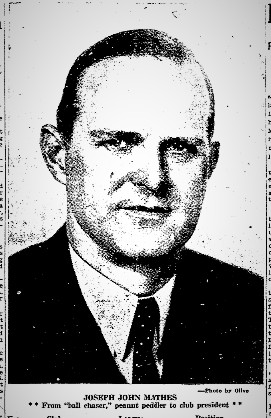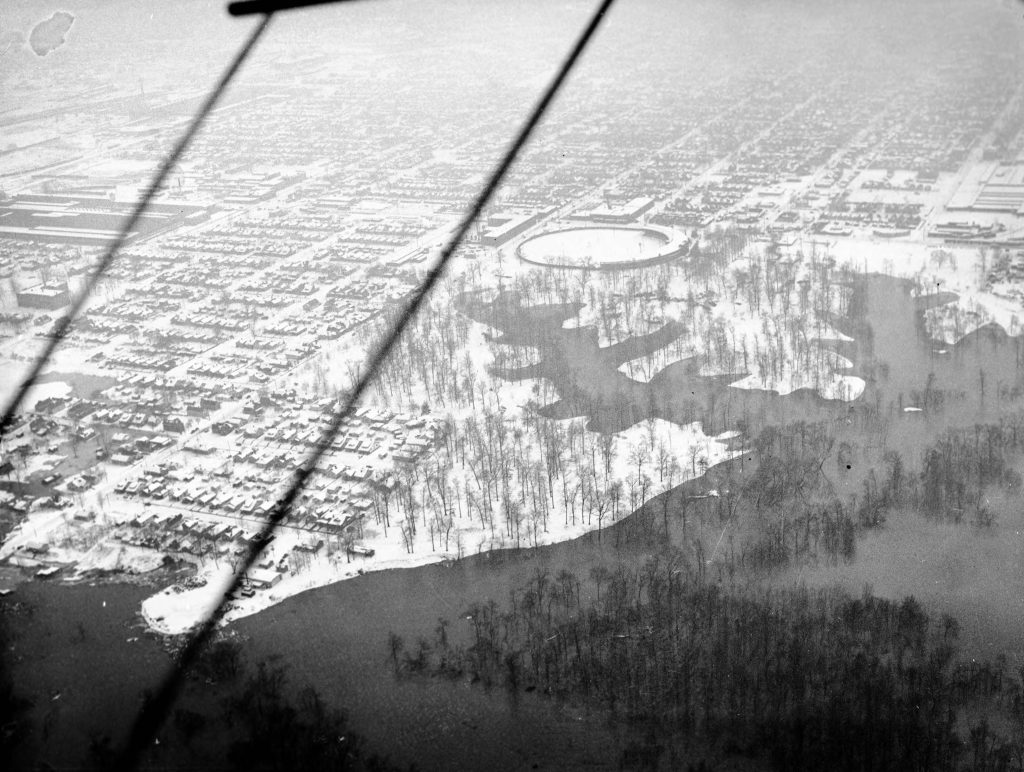On December 2, 1936, with little fanfare or warning, Joe Mathes, a veteran baseball player and minor league manager, was named manager of the new Evansville Hubs in the new Three-I League for the 1937 baseball season. Evansville had been without a team since 1931. The announcement came in a front-page story in the Courier. Mathes was just back from representing Manson Reichert and Evansville at a meeting of the Three-I the previous Sunday. Team co-owner Reichert was to attend as well but was told that his presence wasn’t necessary. Mathes went alone and came back with a team.

The naming of Mathes as manager and co-owner lent an air of completeness to the transaction. Mathes had good major and minor league pedigrees. Mathes’ baseball resume’ featured stints as a major league second baseman with the Philadelphia Athletics and the Boston Braves. He spent 1914 with St. Louis in the Federal League, and he managed, coached and scouted throughout the minor leagues since his playing days ended. He scouted for the St. Louis Cardinals the previous year and resigned the position to take on the role of a minor league team co-owner in Evansville.
Although Mathes had been in the Cardinal organization for the past 10 years, Reichert pointed out that he didn’t think Evansville would be a St. Louis farm team.
“This hasn’t been definitely decided,” Reichert said, “but Mathes and I hope to go it alone.”
Mathes and Reichert went to work. In January of 1937 the school board agreed to a rental fee of $1,500 per season for the use of Bosse Field, with the board operating the park when the team was out of town. For the installation of lights, the school board agreed to refund up to $5,000 in rental to the baseball club over a five-year period. Without a big-league affiliation, the task of gathering players for the new team also fell on Mathes.
“It’s a gamble,” Mathes said, “but I think it’s a good one. We will pay out $7,500 in rent for five years and can receive up to $5,000 back for lights. I hope the league will go right on through for five years.” The use of the word “hope” was, perhaps, prescient.
In early January 1937 the Courier ran a story stating that the Ohio River might reach flood stage of 35 feet within a week. It had been a balmy winter with lots of rain, but the story didn’t indicate that there was anything to be alarmed about. Then it began to rain again. The rain was followed by ice storms, more torrential rain, and then a heavy snow that quickly turned to slush. In all it was the wettest month in local history. The Ohio eventually topped out at nearly 54 feet, surpassing Evansville’s 1913 flood record of about 48 feet. On January 24, martial law was invoked in Evansville due to the devastation and displacement of citizens to avoid the high waters. When the river finally crested, and waters started to recede, nearly 4,000 WPA workers helped start the job to clean up the mess in early February.
Former local baseball men like Punch Knoll, Sylvester Simon and G.A. Beard were all victims of the flood, which ruined furniture and homes. But none of the flood reached Bosse Field.
Late in January of 1937, when Evansville was hit by epic flooding, Mathes was away looking for players to sign for the new club. When he returned to the city in mid-February, he did so with much trepidation. He expected to see half the town underwater and the other half washed away. Even his baseball friends had been patting him on the back and saying, “too bad, Joe” ever since the flood. Mathes was pleasantly surprised to see how well Evansville had recovered. He told a writer he was going to have “one tough Class-B ball club” when the season kicked off in May. Mathes was the man. Everything was clicking.

Bosse Field (above) was spared the flood’s ravages
1937 Aerial Photo
Everything was clicking until March 1. The proverbial roof caved in before the tradition of Spring training began.
“Bloomington is Readmitted to the Three-I” was lead headline in The Pantagraph, the Bloomington, Illinois local newspaper on March 1. Local officials there were rejoicing after leaving a meeting with league officials at that city’s Hotel Morrison the night before. They had just gotten word from league magnates that Bloomington would be the sixth and final Three-I League member for 1937, instead of Evansville. From the beginning, Bloomington was mentioned as a potential member if the league could find an eighth team, but no one in Evansville saw this coming.
The Pantagraph speculated that the decision to boot Evansville was due to two main factors. First, there was a disagreement between Mathes and the city over the Bosse Field rental fee. Second, the recent flooding in Evansville caused so much financial hardship to residents that league leaders felt baseball might not be supported for some time. The Sporting News reported that Mathes was present at the Hotel Morrison meeting. The weekly sports journal stated that Evansville was pulled because it was “unable to obtain a suitable park.”
On March 2, 1937, Courier Sports Editor Dan Scism wrote that Evansville baseball fans were “scratching their heads and wondering how come” the new Three-I franchise suddenly transferred to Bloomington the day before. Reichert was “bewildered as anybody,” said Scism.
The logical conclusions were that several factors added up to a financial burden that Mathes could not handle. The Bosse Field rental terms were risky. He promised new lights in return for the yearly refunds, but the estimated $4,500 up-front installation cost may have been too much to handle before any revenue came in from ticket sales. Mathes had also put 20 players under contract, at a total out-of-pocket expense of $2,000, during his winter journeys. Speculation was Mathes was simply tapped out. Fears that fans wouldn’t show up because of flood devastation were justifiable, and if he couldn’t afford the lights, the park was not suitable by 1937 standards.
Reichert was unable to reach Mathes about the change before the Bloomington deal was done. No professional baseball would be played in Evansville during 1937. Mathes was not the manager of the 1937 Bloomington team, named the “Bengals”, when they took the field. In fact, Mathes never managed a professional team again. The Sporting News wrote that Bloomington didn’t own a single player at the time they replaced Evansville but had “the promise of eight on option” and would also “inherit” the players that were signed for Evansville, which must have been a relief to Mathes. The league’s choice to place the franchise in Bloomington didn’t turn out all that great. Along with Terre Haute, the hastily assembled Bengals dropped out of the league on July 4, leaving the Three-I with only four teams to finish the season.
Scism ran into Mathes at the Minor League Winter Baseball meetings in Milwaukee during December 1937. There Mathes told the sports editor he regretted having to pull out of Evansville, but that he had “no alternative.” Mathes returned to scouting positions with St. Louis and eventually rose to become head of the Cardinals Farm System. He died in St. Louis in 1978 at the age of 87.
“He (Mathes) must have been overmatched in the pocketbook,” said Scism in his column on the subject. Mathes disappeared from the Evansville reporters after that.
Reichert vowed to do all he could to bring “league ball” to Evansville again. Reichert was a doer, as the Evansville people would see in many areas of their lives. There was credible hope. His father, Louis, had brought professional baseball to Bosse Field. Manson had owned franchises before and loved baseball.

Leave a Reply